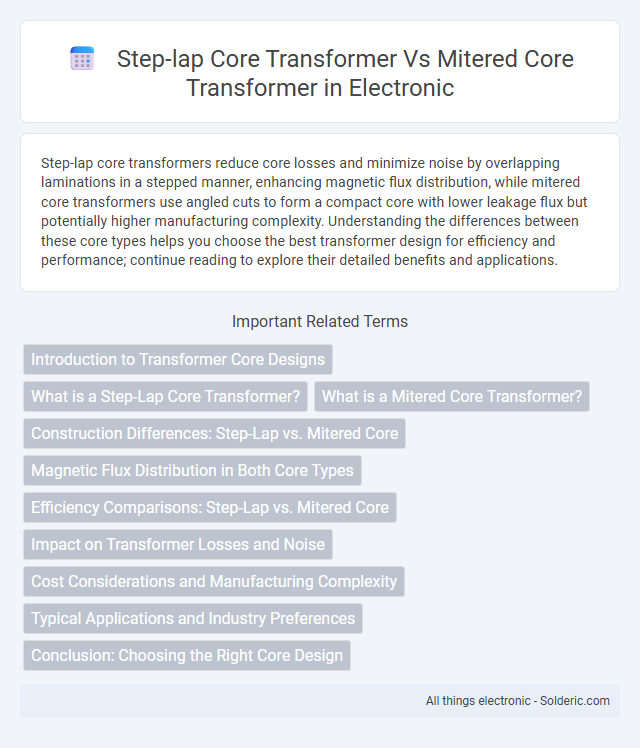Step-lap core transformers reduce core losses and minimize noise by overlapping laminations in a stepped manner, enhancing magnetic flux distribution, while mitered core transformers use angled cuts to form a compact core with lower leakage flux but potentially higher manufacturing complexity. Understanding the differences between these core types helps you choose the best transformer design for efficiency and performance; continue reading to explore their detailed benefits and applications.
Comparison Table
| Feature | Step-Lap Core Transformer | Mitered Core Transformer |
|---|---|---|
| Core Joint Type | Overlapping stepped joints | Angled mitered joints |
| Flux Leakage | Minimal flux leakage due to overlapping | Reduced flux leakage with precise mitered fit |
| Core Losses | Lower core losses by gradual flux transition | Low core losses from tight miter joint |
| Manufacturing Complexity | Moderate complexity with stepped laminations | High complexity due to precise miter cuts |
| Cost | More cost-effective for medium power ratings | Higher cost, used in high-performance applications |
| Mechanical Strength | Good mechanical strength | Excellent mechanical strength at joints |
| Applications | Common in distribution and power transformers | Used in high-efficiency, high-frequency transformers |
Introduction to Transformer Core Designs
Step-lap core transformers feature overlapping laminations to reduce the core's magnetic reluctance and minimize eddy current losses, enhancing efficiency and reducing noise. Mitered core transformers use precisely cut mitered joints to tightly fit laminations, which improves magnetic flux continuity and reduces leakage flux for better performance in compact designs. Your choice between these core designs impacts transformer efficiency, noise levels, and manufacturing complexity depending on the application requirements.
What is a Step-Lap Core Transformer?
A Step-Lap Core Transformer features laminated core segments overlapped in a stepped pattern to minimize magnetic flux leakage and reduce core loss, enhancing efficiency. This design improves the magnetic coupling between core laminations by distributing flux more evenly compared to sharp, mitered joints. The step-lap construction is particularly advantageous in minimizing audible noise and eddy current losses in power transformers.
What is a Mitered Core Transformer?
A mitered core transformer features core laminations cut at precise angles and joined together to minimize magnetic reluctance, enhancing efficiency and reducing core losses. This design creates a tighter magnetic path compared to step-lap cores, improving flux continuity and lowering audible noise. Mitered cores are commonly used in transformer applications requiring high performance with reduced size and weight.
Construction Differences: Step-Lap vs. Mitered Core
Step-lap cores feature overlapping laminations arranged in a stepped pattern to minimize air gaps and reduce flux leakage, improving magnetic efficiency. Mitered cores use precisely cut, angled laminations joined at miters to form sharp corners, which decreases losses by maintaining better flux path continuity. Understanding these construction differences helps optimize your transformer's performance based on specific application requirements.
Magnetic Flux Distribution in Both Core Types
Step-lap core transformers exhibit improved magnetic flux distribution by overlapping laminations to reduce flux leakage and minimize eddy current losses, enhancing efficiency. Mitered core transformers direct magnetic flux through precise 45-degree joints, providing a more uniform flux path with lower reluctance at the corners, resulting in reduced hysteresis losses. Understanding these differences in flux distribution helps you choose the optimal core type for applications requiring efficient magnetic performance and minimal energy loss.
Efficiency Comparisons: Step-Lap vs. Mitered Core
Step-lap core transformers exhibit higher efficiency due to reduced core losses and improved magnetic flux distribution compared to mitered core transformers. The overlapping joints in step-lap cores minimize air gaps and reluctance, which decreases hysteresis and eddy current losses. In contrast, mitered cores, though easier to manufacture, typically suffer from higher losses because of abrupt joint angles causing flux leakage and increased magnetic resistance.
Impact on Transformer Losses and Noise
Step-lap core transformers reduce eddy current and hysteresis losses by overlapping laminations, which enhances magnetic flux continuity and decreases core losses compared to mitered core transformers. The interlocking design also limits vibration and magnetostriction effects, resulting in lower operational noise levels. If you prioritize energy efficiency and quiet performance, step-lap core transformers offer significant advantages over mitered core types.
Cost Considerations and Manufacturing Complexity
Step-lap core transformers generally offer lower manufacturing complexity and cost due to their simpler stacking process and reduced precision requirements, making them suitable for cost-sensitive applications. Mitered core transformers require precise cutting and assembly of core segments, increasing production time and expenses but providing better magnetic performance and reduced core losses. Your choice depends on balancing the importance of cost efficiency against the desired electrical efficiency in the final transformer design.
Typical Applications and Industry Preferences
Step-lap core transformers are preferred in power distribution and industrial applications due to their lower eddy current losses and improved magnetic flux control, making them ideal for high-efficiency and high-reliability systems. Mitered core transformers, favored in smaller transformers and audio-frequency applications, offer reduced core volume and better performance at high frequencies, fitting well with compact designs and specialized electronics. Industry preferences lean towards step-lap cores for large-scale power plants and utility grids, while mitered cores dominate in consumer electronics and high-frequency signal processing.
Conclusion: Choosing the Right Core Design
Selecting between a step-lap core transformer and a mitered core transformer depends on your specific application needs, efficiency goals, and manufacturing constraints. Step-lap cores offer improved flux continuity and reduced core losses, making them ideal for high-efficiency transformers, while mitered cores provide easier assembly and lower manufacturing costs. Your choice should balance performance requirements with budget considerations to optimize transformer reliability and lifespan.
step-lap core transformer vs mitered core transformer Infographic

 solderic.com
solderic.com